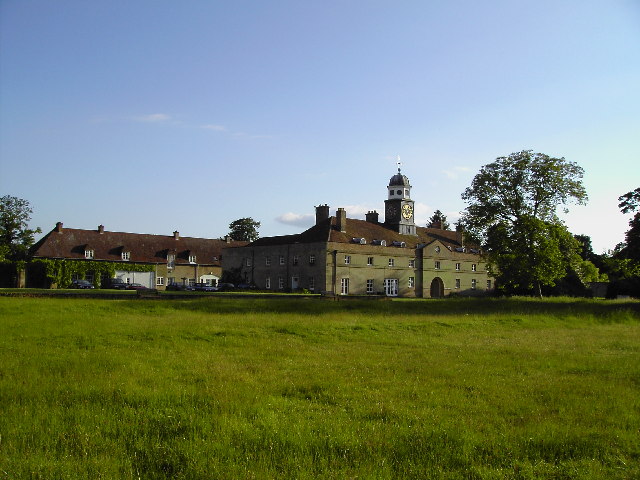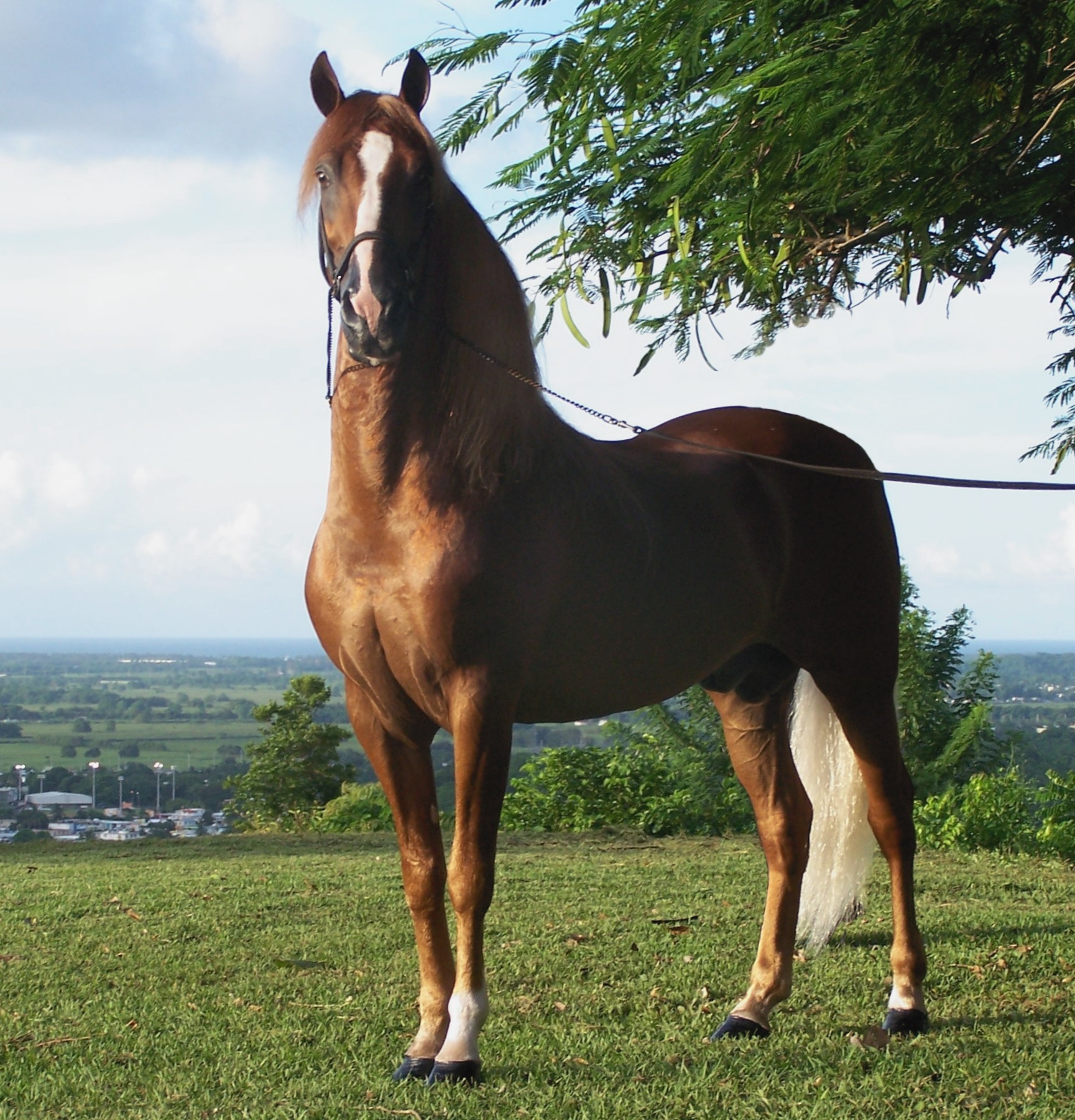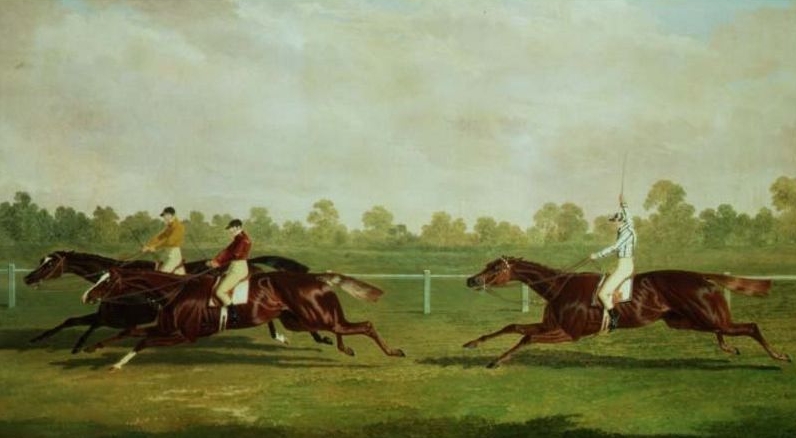|
Blank (horse)
Blank (1740–1770) was a British Thoroughbred racehorse and sire. He only won one race, but became a very successful sire and was British Champion sire in 1762, 1764 and 1770. Background Blank was a bay colt bred by the 2nd Earl of Godolphin and foaled in 1740. He was sired by Godolphin Arabian, who was an Arabian horse and three-time Champion sire. Amongst Godolphin Arabian's other progeny were Lath, Cade, and Regulus. Blank's dam was Little Mare, also known as Amorett, who was a daughter of Flying Wigg. Racing career Blank made his racecourse debut aged six at Newmarket in April 1746. He rarely raced and only won one race, which was a match race over three miles against Cumberland in 1748 at Newmarket. Stud career After retiring from racing Blank became a very successful stallion and was British Champion sire in 1762, 1764 and 1770. He stood at Grimsthorpe in Lincolnshire and his best racing progeny included Ancaster, Great Subscription Purse and 1200 Guineas Stak ... [...More Info...] [...Related Items...] OR: [Wikipedia] [Google] [Baidu] |
Godolphin Arabian
The Godolphin Arabian (–1753), also known as the Godolphin Barb, was an Arabian horse who was one of three stallions that founded the modern Thoroughbred (the others were the Darley Arabian and the Byerley Turk). He was named after his best-known owner, Francis Godolphin, 2nd Earl of Godolphin. Origins The Godolphin Arabian was foaled about 1724 in Yemen and moved several times before reaching England. At some early age, he was exported, probably via Syria, to the stud of the bey of Tunis. From there he was given to Louis XV of France in 1730. It is believed he was a present from monarch to monarch. Not valued by his new French owner, it is believed he was used as a carthorse. The horse was then imported from France by Edward Coke and sent to his stud at Longford Hall, Derbyshire, where he remained until the death of his owner in 1733. He was bequeathed to Roger Williams, "proprietor of the St. James's Coffee House", who inherited Coke's stallions. He was bought by the 2 ... [...More Info...] [...Related Items...] OR: [Wikipedia] [Google] [Baidu] |
Stallion
A stallion is a male horse that has not been gelded (castrated). Stallions follow the conformation and phenotype of their breed, but within that standard, the presence of hormones such as testosterone may give stallions a thicker, "cresty" neck, as well as a somewhat more muscular physique as compared to female horses, known as ''mares'', and castrated males, called ''geldings''. Temperament varies widely based on genetics, and training, but because of their instincts as herd animals, they may be prone to aggressive behavior, particularly toward other stallions, and thus require careful management by knowledgeable handlers. However, with proper training and management, stallions are effective equine athletes at the highest levels of many disciplines, including horse racing, horse shows, and international Olympic competition. "Stallion" is also used to refer to males of other equids, including zebras and donkeys. Herd behavior Contrary to popular myths, many stallions do no ... [...More Info...] [...Related Items...] OR: [Wikipedia] [Google] [Baidu] |
Racehorses Bred In The Kingdom Of Great Britain
Horse racing is an equestrian performance sport, typically involving two or more horses ridden by jockeys (or sometimes driven without riders) over a set distance for competition. It is one of the most ancient of all sports, as its basic premise – to identify which of two or more horses is the fastest over a set course or distance – has been mostly unchanged since at least classical antiquity. Horse races vary widely in format, and many countries have developed their own particular traditions around the sport. Variations include restricting races to particular breeds, running over obstacles, running over different distances, running on different track surfaces, and running in different gaits. In some races, horses are assigned different weights to carry to reflect differences in ability, a process known as handicapping. While horses are sometimes raced purely for sport, a major part of horse racing's interest and economic importance is in the gambling associated wi ... [...More Info...] [...Related Items...] OR: [Wikipedia] [Google] [Baidu] |
British Champion Thoroughbred Sires
British may refer to: Peoples, culture, and language * British people, nationals or natives of the United Kingdom, British Overseas Territories, and Crown Dependencies. ** Britishness, the British identity and common culture * British English, the English language as spoken and written in the United Kingdom or, more broadly, throughout the British Isles * Celtic Britons, an ancient ethno-linguistic group * Brittonic languages, a branch of the Insular Celtic language family (formerly called British) ** Common Brittonic, an ancient language Other uses *''Brit(ish)'', a 2018 memoir by Afua Hirsch *People or things associated with: ** Great Britain, an island ** United Kingdom, a sovereign state ** Kingdom of Great Britain (1707–1800) ** United Kingdom of Great Britain and Ireland (1801–1922) See also * Terminology of the British Isles * Alternative names for the British * English (other) * Britannic (other) * British Isles * Brit (other) * Bri ... [...More Info...] [...Related Items...] OR: [Wikipedia] [Google] [Baidu] |
1770 Racehorse Deaths
Year 177 ( CLXXVII) was a common year starting on Tuesday (link will display the full calendar) of the Julian calendar. At the time, it was known as the Year of the Consulship of Commodus and Plautius (or, less frequently, year 930 ''Ab urbe condita''). The denomination 177 for this year has been used since the early medieval period, when the Anno Domini calendar era became the prevalent method in Europe for naming years. Events By place Roman Empire * Lucius Aurelius Commodus Caesar (age 15) and Marcus Peducaeus Plautius Quintillus become Roman Consuls. * Commodus is given the title ''Augustus'', and is made co-emperor, with the same status as his father, Marcus Aurelius. * A systematic persecution of Christians begins in Rome; the followers take refuge in the catacombs. * The churches in southern Gaul are destroyed after a crowd accuses the local Christians of practicing cannibalism. * Forty-seven Christians are martyred in Lyon (Saint Blandina and Pothinus, bishop o ... [...More Info...] [...Related Items...] OR: [Wikipedia] [Google] [Baidu] |
1740 Racehorse Births
Year 174 ( CLXXIV) was a common year starting on Friday (link will display the full calendar) of the Julian calendar. At the time, it was known as the Year of the Consulship of Gallus and Flaccus (or, less frequently, year 927 ''Ab urbe condita''). The denomination 174 for this year has been used since the early medieval period, when the Anno Domini calendar era became the prevalent method in Europe for naming years. Events By place Roman Empire * Empress Faustina the Younger accompanies her husband, Marcus Aurelius, on various military campaigns and enjoys the love of the Roman soldiers. Aurelius gives her the title of ''Mater Castrorum'' ("Mother of the Camp"). * Marcus Aurelius officially confers the title ''Fulminata'' ("Thundering") to the Legio XII Fulminata. Asia * Reign in India of Yajnashri Satakarni, Satavahana king of the Andhra. He extends his empire from the center to the north of India. By topic Art and Science * ''Meditations'' by Marcus Aurelius is ... [...More Info...] [...Related Items...] OR: [Wikipedia] [Google] [Baidu] |
Equine Coat Color
Horses exhibit a diverse array of coat colors and distinctive markings. A specialized vocabulary has evolved to describe them. While most horses remain the same color throughout life, a few, over the course of several years, will develop a different coat color from that with which they were born. Most white markings are present at birth, and the underlying skin color of a healthy horse does not change. Some Equine coat colors are also related to the breed of horse, like the Friesian breed for instance. The basic outline of equine coat color genetics has largely been resolved, and DNA tests to determine the likelihood that a horse will have offspring of a given color have been developed for some colors. Discussion, research, and even controversy continues about some of the details, particularly those surrounding spotting patterns, color sub-shades such as " sooty" or " flaxen", and markings. Basic coat colors The two basic pigment colors of horse hairs are pheomelanin ("red ... [...More Info...] [...Related Items...] OR: [Wikipedia] [Google] [Baidu] |
Darley Arabian
The Darley Arabian (foaled c. 1700) was one of three dominant foundation sires of modern Thoroughbred horse racing bloodstock. The other two founders were the Godolphin Arabian and the Byerley Turk. This bay Arabian horse was bought in Aleppo, Syria, by Thomas Darley in 1704 and shipped to Aldby Park in England, as a present for his brother. One author in 1840 described Darley Arabian's arrival in England during the reign of Queen Anne as the event which "forms the great epoch from which the history of the Turf '' Flat_racing.html" ;"title="s in "Flat racing">turf racing"' should be dated". There he stood at stud, usually private but sometimes open to outside mares. He was the leading sire in Great Britain and Ireland in 1722. By all accounts, the Darley Arabian stood about 15 hands high and was of substantial beauty and refinement.Ahnert, Rainer L. (editor in chief), "Thoroughbred Breeding of the World", Pozdun Publishing, Germany, 1970 The Darley Arabian sired the u ... [...More Info...] [...Related Items...] OR: [Wikipedia] [Google] [Baidu] |
Goldfinder (horse)
Goldfinder (1764–1789) was an undefeated Thoroughbred racehorse. His wins included two Newmarket Challenge Cup and Whips. After retiring from racing he became a successful sire. Background Goldfinder was a bay colt foaled in 1764. He was bred by John St Leger Douglas and was sired by the undefeated racehorse and Champion sire Snap. His dam was a daughter of Blank, another Champion sire. Racing career Goldfinder made his racecourse debut at Newmarket on 5 April 1768, beating two opponents to win a sweepstakes of 200 guineas each (known as the 1400 Guineas). On 29 April he beat six rivals to win the Ascot Stakes. His next race came in October, where he beat five rivals (including Lord Bolingbroke's 4/5 favourite Sejanus) to win another sweepstakes of 200 guineas each. The next day he was due to race a filly belonging to Sir John Moore, but Moore paid a 300 guinea forfeit and withdrew his horse. In his last race as a four-year-old he won the Contribution Stakes, beating four ... [...More Info...] [...Related Items...] OR: [Wikipedia] [Google] [Baidu] |
Highflyer (horse)
Highflyer (1774 – 18 October 1793) was an undefeated Thoroughbred racehorse and a very successful sire of the 18th century.Ahnert, Rainer L. (editor in chief), “Thoroughbred Breeding of the World”, Pozdun Publishing, Germany, 1970 Breeding Bred by Sir Charles Bunbury, the fifth Baronet, the colt was foaled at Great Barton, in 1774. Highflyer's sire was the important Herod, one of the foundation stallions for the classic Thoroughbred, and himself an excellent racehorse and stud, producing Florizel (b.c. 1768) and Woodpecker (ch.c. 1773). His dam, Rachel (1763) was by Blank, and out of a mare by Regulus, both stallions by the Godolphin Arabian, making Rachel inbred 2x3 to the great stallion. Blank also sired Pacolet (1763). Highflyer was a half-brother to Mark Anthony (b c 1767 Spectator) who sired The Derby winner Aimwell. [...More Info...] [...Related Items...] OR: [Wikipedia] [Google] [Baidu] |
Doncaster Cup
The Doncaster Cup is a Group 2 flat horse race in Great Britain open to horses aged three years or older. It is run at Doncaster over a distance of 2 miles 1 furlong and 197 yards (3,600 metres), and it is scheduled to take place each year in September. History The event was established in 1766, and it was originally called the Doncaster Gold Cup. It pre-dates Doncaster's St. Leger Stakes by ten years, and is the venue's oldest surviving race. It was initially held at Cantley Common, and moved to its present location in 1776. During the early part of its history the race was contested over 4 miles. It was shortened to 2 miles and 5 furlongs in 1825, and reduced to 2 miles and 2 furlongs in 1891. It was cut by another furlong in 1908, and restored to its previous length in 1927. The present system of race grading was introduced in 1971, and for a period the Doncaster Cup was classed at Group 3 level. It was promoted to Gr ... [...More Info...] [...Related Items...] OR: [Wikipedia] [Google] [Baidu] |
1200 Guineas Stakes
The 1200 Guineas Stakes was a flat horse race in Great Britain open to thoroughbreds aged five years. It was run at Newmarket and was one of the most important races of the second half of the 18th century. History The 1200 Guineas was established in 1753 to be first run during Easter week of 1757. It was established by the Duke of Cumberland, 3rd Duke of Ancaster, 3rd Duke of Marlborough, 2nd Marquess of Rockingham, Marquess of Hartington, Marquess of Granby, 2nd Earl of Godolphin, 2nd Earl of Northumberland, 10th Earl of Eglinton, 3rd Duke of Richmond, 1st Earl of Gower and Thomas Duncombe. They agreed the race was to be run over the Beacon course at Newmarket and would be open to five-year-old horses and mares. They paid a 100 guineas subscription each to enter their horse and all runners would carry nine stone. The race was initially to be run for five consecutive years from 1757, but was subsequently renewed in 1762. Records to 1786 Leading owner (4 wins): * 1st B ... [...More Info...] [...Related Items...] OR: [Wikipedia] [Google] [Baidu] |




